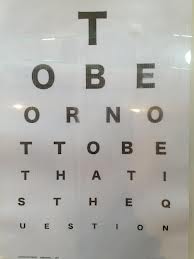Investing in a doctoring degree in Audiology hinges on expectations and outcomes that should be anchored in real data. We’re not there yet, but discussing it is a start. Last week left off here:
it boils down to doing a self-examination of expectations and anticipations in order to forecast whether the graduate degree is a good or poor investment. The wannabe Audiologist’s rational consumption choice is supposed to maximize her Utility by a selective process in which she chooses the best opportunity available and within her budget. Does it?
To which Kevin Liebe, AuD responded by referencing his recent article on Audiology Students’ Views:
I think the particularly damning statement on the subject of AuD education and ROI is from Chasity Moore, when she says that some students in her undergraduate program interested in audiology chose to become SLPs instead because, “it takes less time, the days off are better and they often make more money.” Ouch!
OK, Chasity and Kevin. It’s a long process to collect enough data to attempt rational consumption decision-making on this topic. I promised some numbers and we’ll start today with Growth and see how those number stack up in Chasity’s analysis.
Growth in Health-Related Occupations and Professions
Some professions are growing, others are dying off. We don’t need the Bureau of Labor Statistics (BLS) to tell us that becoming the village blacksmith is out, but who knew that holistic medicine is a dead end these days? So says Forbes Magazines list of 10 “top” dying professions. I wouldn’t have guessed.
Audiology is not dying but it’s also not among the top 20 Fastest Growing Occupations, according to the BLS. But a disproportionate number of health-related “assisting” occupations are in the top ranks (Table 1). It may not be so great to make that list: in general, occupations that pay the least are growing fastest, although sonographers do well on both counts. None of the vocations require anything close to a doctoral degree.
|
Occupations |
Growth rate, 2010-2020 |
2010 Median Pay |
|
Medical Secretaries |
41% |
30.53K |
|
OT Assistants |
43% |
51.01K |
|
Dx Medical Sonographers |
44% |
64.38K |
|
PT Assistants |
46% |
$49.69K |
|
Veterinary Techs |
52% |
$29.71K |
|
Home health aides |
70% |
20.56K |
|
Personal Care Aides |
70% |
19.64K |
Table 1. Selected Occupations from BLS Fastest Growing Occupations
Some argue that professions of the type shown in Table 1 are complementary and necessary to doctoring professions such as Audiology. The arguments have validity but they are counter-weighted by opposing arguments that these lower-paid, growing legions are our future competitors because “support” need not imply “supervised.“
Indeed, Christine Diles, AuD/Hearing Aid Dispenser made the point last year in a compelling post that contrasted doctoral level Audiologists with hearing aid dispensers. On the assumption that Audiologists with doctorates will survive the onslaught and not go the way of the village blacksmith, let’s shift the focus to licensed healthcare professions.
Folks Like Us
Physical Therapy is the only doctoring profession to makes the “top 20” cut for growth — it comes in 20th. Table 2 compares data from that profession to Audiologists, OTs and SLPs. Despite being one of the two doctoral-level professions represented in the table, Audiologists come in last on wages, number of jobs, and projected increase in actual number of jobs. We’re also Lilliputians among giants in the table.
|
|
||||
|
Median Pay 2010 |
$66,660 |
$66,920 |
$72,320 |
$76,310 |
|
Entry-Level Education |
Doctoral |
Master’s |
Master’s |
Doctoral |
|
Number of Jobs |
13,000 |
123,200 |
108,800 |
198,600 |
|
2010-2020 Growth |
37% |
23% |
33% |
39% |
|
Projected New Jobs, 2010-2020 |
4,800 |
28,800 |
36,400 |
77,400 |
|
Table 2. BLS Occupational Outlook Handbook Summaries of 3 Professions. |
Back to Chasity’s analysis. She was on the right path but didn’t have enough numbers to hit the mark. By her measures of time spent and money made, she should consider switching to OT or sonography. As far as time-off, I didn’t find any numbers comparing that metric among professions, but I’m happy to get them from anyone who wants to chime in.
There are so many metrics that come into play, I welcome help and direction from readers. No doubt, someone like myself finds enormous satisfaction in being an Audiologist and would probably do it for no pay, long hours, and years of schooling. Come to think of it, I have done so in lean times. I’m sure others have as well. Those of us who have chosen the Audiology path derive significant Utility from our career preference. Younger people who are considering Audiology for their future deserve to hear from you!
Next post in this series will look at Growth and Gender effects.
Editor’s Note: Only after publishing this post did I discover that Chuck Berlin, PhD, had already snagged the catchy title in an article he wrote for American Journal of Audiology back in 1992. It’s not available unless you are an ASHA member (a characteristic of special interest groups that irritates economists) but here’s the link in case you are.
photo courtesy of tumblr








I think if anything, this data shows us that the audiology profession needs to clearly define what an audiology aide or technician is and what they can and cant’ do. Clearly when someone can spend about a year and become a HAD (or less), why would they become an aide, unless it was on-the-job training?
I think it’s pretty pathetic that the median pay of audiologists is so close to what some other professional aides are making. Wow! I’m pretty sure it didn’t take them 8 years to become an assistant.